Activists Call for Divestment As Trump Moves Pipelines Forward
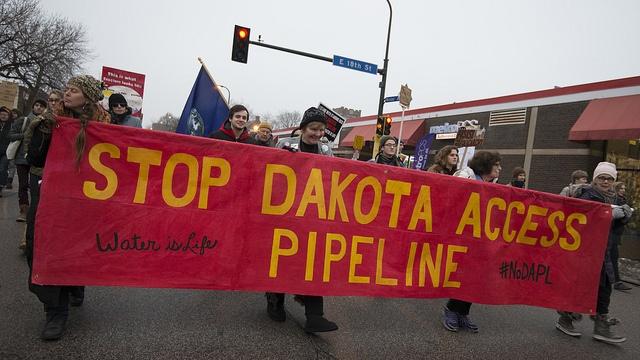

President Donald Trump signed two presidential memoranda on Jan. 24 that essentially green-lighted the Keystone XL and Dakota Access pipelines. The executive orders are just one part in a multi-pronged approach to dismantling the Obama administration's environmental legacy.
As a review: Keystone XL is a 1,100-mile pipeline that will connect oil from tar sands Alberta, Canada, to U.S. refineries on the Gulf Coast. Former President Barack Obama rejected the pipeline in 2015.
Trump’s memorandum resubmits the application to the State Department for a presidential permit to construct and operate Keystone XL, which it needs because it crosses international lines. The State Department will have 60 days to make a final decision on the application by TransCanada, the company that wants to build the pipeline.
Trump’s memorandum for the Dakota Access pipeline directs federal agencies to expedite reviews and approvals for the remaining portion of the pipeline, which would cross the Missouri River.
The Dakota Access pipeline is 1,100 miles long and worth $3.8 billion. It's set to carry around 500,000 barrels crude oil per day from the Bakken and Three Forks oil production areas in North Dakota to a hub in Patoka, Illinois. The pipeline would stretch across four states: North Dakota, South Dakota, Iowa and Illinois.
Both pipelines represent environmental damage, advocates insist. Keystone’s route will go from Alberta, Canada, to Texas. Along its way, spills, explosions or other events could harm ecosystems, pollute water and put public health in jeopardy. The Keystone Pipeline will cut through six states -- and cross the Missouri, Yellowstone and Red rivers, plus the Ogallala Aquifer which supplies water for a quarter of the irrigated land in the U.S. and provides drinking water for 2 million people.
Keystone XL would double the import of tar sands oil into the U.S. The carbon emissions from tar sands oil production is three to four times greater than those from conventional oil, because extracting and refining it is more energy-intensive. The pipeline would transport 830,000 barrels of tar sands oil a day into the U.S. The carbon emissions from that oil are equivalent to over 5.6 million cars added to American roads, according to a report from Friends of the Earth.
Meanwhile, the Dakota Access pipeline is rife with controversy. It would pass within half a mile of the Standing Rock Sioux reservation in North Dakota -- and Native American protesters say building crews have already desecrated sacred burial sites. The pipeline is also set to cross the Missouri River, which supplies drinking water to 17 million Americans, including the Standing Rock Sioux.
Members of the Standing Rock tribe, as well as thousands of their supporters, fiercely opposed the construction — and many are still braving the North Dakota winter in protest camps near the pipeline site.
The concerns cited by the Iowa Chapter of the Sierra Club highlight why people continue to protest the pipeline. The pipeline could pollute water sources, harm farmland, and cause damage to wildlife and sensitive natural areas, the chapter says. The pipeline would add 50 million tons of carbon to our atmosphere, equal to 10 million cars or 15 coal plants, according to the Grassroots Global Justice Alliance (GGJA).
The Dakota Access route cuts across prairie lands, farmland and waterways, including the mighty Missouri River. It cuts across treaty lands of the Oceti Sakowin and will cross along the northern borders of the Standing Rock Sioux. It will pass only 12 miles upstream from the Standing Rock Sioux’s drinking water supply, which impacts over 10,000 people.
Both pipelines carry a risk of an oil spill. Canada and the U.S. each suffered a major pipeline spill in the past week alone, only further amplifying advocates' calls to limit pipeline construction.
“They are both terrible ideas for several reasons,” Doug Norlen, economic policy program director of Friends of the Earth, told TriplePundit of the pipelines.“The Dakota Access pipeline route is a human rights atrocity in terms of its impacts on the Standing Sioux tribal rights, the poisoning of local communities and watersheds. [Both pipelines are] perpetuating a global industry that is doing harm around the planet.”
Activists vow to keep fighting, call on banks to divest
Trump’s greenlighting of the two pipelines will not stop activists from fighting against them. Speaking about the Keystone XL pipeline, Norlen said, “People will take it to the streets, the states and to the courts.”He went on to point out: “Trump is very thin-skinned, and we will definitely be seeing how sad he is when people take this movement to the streets, including those around his new house.”
One way that activists have fought against the Dakota Access pipeline is to call for the 17 banks that directly fund it to divest.
“Banks should reject Energy Transfer Equity’s preliminary request for $2.2 billion, given the company’s climate-wrecking business model and egregious human rights abuses at Standing Rock,” Jason Opeña Disterhoft, senior campaigner for the Rainforest Action Network, said in a statement. “Here’s an opportunity for banks to do the right thing. Stay away from funding this loan and steer clear of investing in Energy Transfer again.”
The banks that are directly involved include Citibank and Wells Fargo.
“It's going to continue,” Norlen said of the call for divestment. "[Activists] have greatly advanced the use of financial campaign tools and taken it to a new level, and we can expect that kind of approach to continue."
Image credit: Flickr/Fibonacci Blue
Ikea Acquires Canadian Wind Farm On the Quest Toward Energy Independence
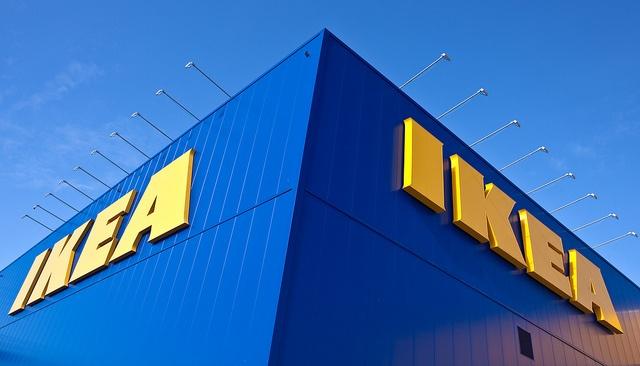

Ikea is a trailblazer when it comes to investing in solar and wind power projects -- and spent big on renewables even before they became cost-competitive with fossil fuels.
Already claiming to be the largest retail wind power investor in Canada, Ikea boosted its clean-energy credentials by purchasing its second wind farm in the province of Alberta.
Last week, the global furniture and housewares giant bought up an 88-megawatt wind power installation 80 miles east of Calgary. The Wintering Hills Wind Farm, which has been in operation since 2012, has 55 turbines spread across 24 square miles of Alberta prairies. Ikea claims the power Wintering Hills generates is enough to electrify 54 of its stores, or almost 26,000 Canadian households.
Ikea did not disclose details about this financial transaction. But according to the CBC, the wind farm’s current owners, TransAlta and Teck Resources, will receive $91 million (or CAD $119.6 million) from Ikea.
The purchase of Wintering Hills is yet another step in Ikea’s move to become entirely energy independent by 2020.
The company says it spent at least $3.2 billion in its quest to become entirely energy- and resource-efficient, with two-thirds of that sum spent on clean-energy projects worldwide.
The privately-owned company is cagey when it comes to releasing precise statistics and financial information. But its latest investment in Canada should help the company achieve its publicly-stated goal of producing more energy than it consumes by 2020.
In addition, Ikea is spending another $1.1 billion (1 billion euros) on a more sustainable supply chain, which includes investments in forestry, the development of alternative materials, recycling and more clean-energy development.
Meanwhile, actions taken within stores indicate the company is walking the walk. For example, the retailer phased out CFL bulbs last fall and now sells only LED lighting. As for its popular food stores that tempt customers after they check out, Ikea has also promised to purchase more responsibly-sourced palm oil. And when it comes to its popular and cheaply-priced textiles, the company invests in startups that aim to reduce their environmental impact.
But despite what it describes as a holistic approach to sustainability, it is on the renewables front where Ikea shines. According to the company’s most recent sustainability report, its focus on renewables far outpaces the competition.
Ikea says it owns 327 wind turbines outright and has installed over 730,000 solar panels on its buildings worldwide. When adding the heat that it sources from renewables, along with some biomass-fueled electricity, the company generated over 3.2 gigawatts of power during fiscal 2016, or about 71 percent of its total energy consumption.
Just two years earlier, the company “only” generated 42 percent of its power from renewables, indicating that its goal of becoming a net energy exporter after this decade is a realistic plan.
Meanwhile, the company will invest in energy storage pilot projects in Sweden and Australia in the coming year, as cost-effective onsite storage would make it more seamless for Ikea to attain that magic 2020 metric. And the retailer claims the reuse of lithium-ion batteries from its fleet of forklift trucks and other vehicles could help the company rely on renewables even more as most of its facilities operate 24/7.
For years, Ikea was mocked as the chain of cavernous stores pitching furniture with names long on vowels but short on quality. The company’s progress on renewables, however, has nudged other companies to follow suit.
And in the meantime, Ikea's investment in clean technologies not only allows the company to do its part to mitigate climate change, but also gives customers the option to purchase products that are more sustainable and energy efficient.
Image credit: Håkan Dahlström/Flickr
Does Elon Musk Have Trump's Ear? And If So, Will It Matter?
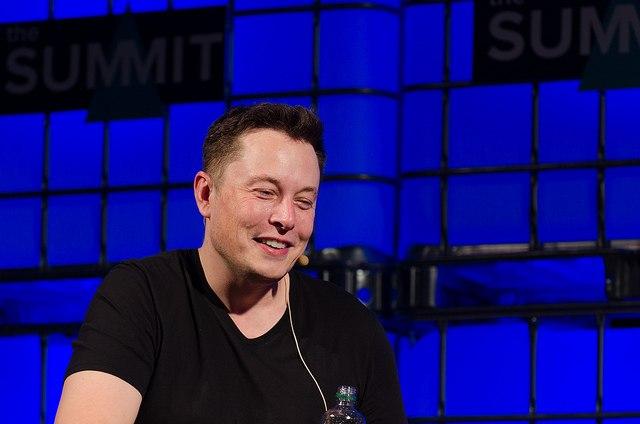

Donald Trump’s election could spell bad news for Elon Musk, the outspoken entrepreneur and brainchild of Tesla Motors and SolarCity. A leader of the two companies whose survival depends on alternative energy couldn’t possibly seek solace in a president so apt to support fossil fuels while calling climate change a hoax.
But as Morgan Stanley automotive analyst Adam Jonas told the New York Times: “You don’t have to be anti-electric to be pro-fossil fuel.”
Musk appears to be defying expectations and creating an alliance with the president, despite clear differences.
For one, Musk is an adamant supporter of a carbon tax. Trump, on the other hand, has discredited climate change and assembled a pro-fossil fuel cabinet, with his picks for Secretary of State and Energy Secretary going to Rex Tillerson and Rick Perry, respectively.
Despite their differences and despite Musk openly criticizing Trump during his campaign, the tech billionaire isn’t turning his back to Trump. In fact, he’s embracing Trump’s presidency -- accepting a position on the president’s manufacturing counsel and drawing headlines reading, “Opposites Attract? Why Musk and Trump Are Having a Bromance.”
While it’s true that Trump hasn’t been particularly partial to the environmental industry in his first week in office, one of his main aims is to boost American manufacturing. Musk’s Tesla represents some overlap in that field, boasting high-tech manufacturing jobs right in the United States.
Sure, Tesla is an all-electric car manufacturer working in a country where the president is more slanted toward fossil fuels, but it’s also a business. And after just one week of Donald J. Trump roaming the halls of the White House, Musk’s business is booming.
Tesla stock was close to reaching a record high. And analysts are calling it the “Trump effect.”
The newly-formed relationship between Musk and Trump can be seen in a few ways. On one hand, Musk can have Trump’s ear on environmental issues and start conversations on positions with which Trump’s cabinet disagrees. Musk already made strides in suggesting the carbon tax to Trump. While Trump didn’t openly welcome the idea, he didn’t call it a Chinese hoax like last time.
On the other hand, skeptics are questioning the genuineness in Musk’s relationship with Trump. Are his goals still aligned with environmental concerns, or is he more interested in expanding his net worth?
Trump’s friendship with Musk makes sense, despite his reservations on climate change. Tesla represents a perfect American company. The car company employs 25,000 workers in the U.S. and “could easily double that as it ramps up production for its new Model 3.” Tesla was receiving federal subsidies for its production, but that will end once the company reaches 200,000 vehicles.
All things considered, Musk and Trump’s unlikely partnership is something to keep an eye on.
Photo courtesy of Heisenberg Media via Flickr
Mastercard Winning WFP’s Hunger Hero Award? Priceless.


The United Nations World Food Programme (WFP) commemorated Mastercard with the Hunger Hero award for its effort to curb worldwide hunger. Ajay Banga, president and CEO of Mastercard, accepted the award at the WFP’s annual dinner at the World Economic Forum in Davos, Switzerland.
Mastercard’s aim to fulfill the U.N.’s sustainable development goal of Zero Hunger brought Banga center stage to accept the award from WFP Executive Director Ertharin Cousin.
“Under Ajay’s incredible leadership, Mastercard stands side-by-side with WFP and the people we serve, giving us access to their latest technology, vast network and generous staff to help us in our fight to achieve Zero Hunger,” Cousin said in Davos.
Mastercard’s focus in halting world hunger started in one of the most vulnerable places in the world: Syria.
Since the start of the conflict in 2011, Syria has plummeted into one of the worst humanitarian disasters since World World II. Among the 12 million Syrians displaced as a result of the war, 4.8 million of them found refuge in a nearby Middle Eastern country.
While they may be safe from threats of war, they are still subject to intense discrimination. This discrimination limits their opportunity for employment, leaving them isolated in camps and without any money to support themselves.
This is where Mastercard comes in. In partnership with the WFP, Mastercard enabled the U.N. organization to bring electronic payments to 2.2 million Syrian refugees in Lebanon and Jordan.
With these electronic payments, Syrian refugees can go to local markets and purchase food and goods with prepaid cash cards. The money is also wired automatically to cut out the waiting period. The e-cards gave families $27 a month to buy listed items which included fresh produce, a rare commodity for Syrians struggling to stay afloat.
The company's humanitarian efforts are especially poignant as the Trump administration seeks to bar Syrian refugees from entering the U.S.
Mastercard’s collaboration with its banks and retail partners have also raised funds to give more than 17 million meals to schoolchildren around the world. Analytical research from Mastercard and WFP proved that every dollar invested in meals for school children yields a $6 return based on rewards in improved health and education for kids, according to a press release.
Mastercard leader Banga wants companies to follow in his organization’s path to fix the perception that business is only about making money.
“At Mastercard we believe those efforts begin with the belief that business can be a force for good in the world and that when the public and private sector partner we can be transformative, doing great things that make a meaningful difference,” Banga said.
Banga, despite receiving the award, doesn’t plan to stop now. Mastercard announced its intention to reach 500 million people excluded from financial services by 2020. Such ambition moved Fortune to rank Mastercard seventh on its Change the World list honoring 50 influential companies.
Image credit: Kārlis Dambrāns
California To Vote On Leaving The U.S.
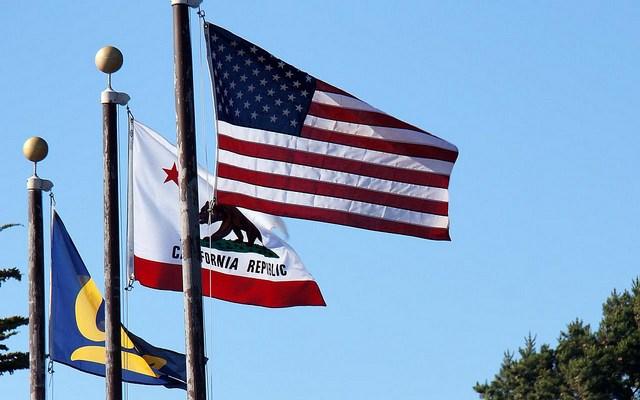

“You know what would make America better? If California would just fall into the sea.”
I received this insight when I asked for questions after a Tulsa Oklahoma Rotary Club presentation on how businesses were making money going green.
That comment is not unusual. Over the years working across America's Heartlands, I have heard pretty negative opinions on California.
Maybe the Golden State is listening to the feedback?
Last week California’s Secretary of State qualified a ballot initiative that will allow Californians to vote on leaving the Union. Think: Britain and their vote on leaving the EU. Fittingly, the press is calling the ballot initiative CalExit.
That might seem like the deal of the century to Heartland Americans. But is it?
CalExit supported by a third of Californians
For those of you who like our wines or Disney movies, please know that CalExit is still below the radar for most Californians. But with the election of Donald Trump, it is gaining support.
Look no further than California if you are seeking a reason, other than voter fraud, for why President Donald Trump did not win the popular vote. Nearly 9 million Californians voted for his Democratic opponent, Hillary Clinton. Our president got less than 4.5 million votes in the state. If all of the 2 million to 3 million fraudulent voters President Trump is investigating had voted in California, he would have still lost the state’s popular vote.
Before Trump's election, 1 in 5 Californians would have voted for secession. The newest polls show a third of Californians would vote to leave the Union. And this is before President Trump has done anything measurable like messing up California’s booming economy or challenging the state’s ability to control its own pollution. If that happens? CalExit could pass with a huge majority.
Is CalExit good for you?
Here is how I answered the Tulsa gentleman’s comment that America would be better off without California.
I asked him if he likes ketchup with his fries. He did. I pointed out that 90 percent of all tomatoes are grown in California.
I asked if he thought we should be using drones to kill terrorists when it was safer than putting our best and bravest in harms’ way. He did. I shared with him that General Atomic, headquartered in San Diego, is America’s drone tech leader.
Not wanting to put him on the spot more than I was enjoying, I then listed the following as reasons why losing California may not be such a good idea for America:
- California is the fifth largest economy in the world. Its economy is twice the size of Texas, the second largest state economy. Only China, Japan, Germany and the U.K. have larger economies than California. And California has figured out how to grow its economy while also reducing pollution.
- California is the world’s technology innovation center. Silicon Valley is now focused on developing artificial intelligence, predictive software and the Internet of Things. These technologies will enable Heartland America to build smart factories and restore their region as a global manufacturing center.
- California is the world’s movie capital. Much of digital gaming is headquartered in California. Mea culpa, our San Fernando Valley is the world’s porn movie capital. But for better or worse, it is California that drives America’s global brand image. California is also the reason, along with football, that we love our big screen TVs.
- California is a breadbasket to the U.S. and the world. It is the world’s fifth largest supplier of food and agriculture.
- California produces more oil than all other states other than Texas and North Dakota.
- California pays more money to the federal government than it receives. In case you are wondering, the five most dependent states to the federal government are Mississippi, New Mexico, Alabama, Louisiana and Tennessee.
How about returning to a UNITED States?
Have we really come to a point where California might vote for secession?
United, we are pretty awesome.
For example, if you haven’t visited Tulsa recently, you should. Millennials, moving into its downtown, are providing the underlying support for Tulsa’s new in-town housing, innovative restaurants and the coolest minor league baseball stadium in the country. I know many of these millennials. They are trying hard to help their state adopt sustainable practices like solar and farm-to-fork dining.
I lived in Atlanta for 20 years. For me, Atlantans define what it means to be gracious and caring.
I was born in St. Louis -- full of good, straight-talking folks you can trust. And where else in the world can you get toasted ravioli?
The point is that we have more going for us than against us. For the most part, we like and admire one another. We should.
With only a population of around 300 million, among 7 billion, we have built the largest economy in the world. Our air and water quality is the envy of the world. Our military is the best because our bravest are dedicated to world peace and service to others. (God bless and protect them.) While the world continues to harm and discriminate because of race, religion or sexual orientation, we stand as diversity’s beacon proclaiming that all human beings have value.
Come on Californians, Heartland Americans, President Trump and Congress, let’s vote for healthy children, clean air and water, more and better paying jobs, respect for all and a safer world.
Then let’s work together to make it happen.
Image credit: Flickr/Alex
Call to companies to eliminate forced labour in textile industry


3p Weekend: In the Trump Era, Uncertainty is the Name of the Game
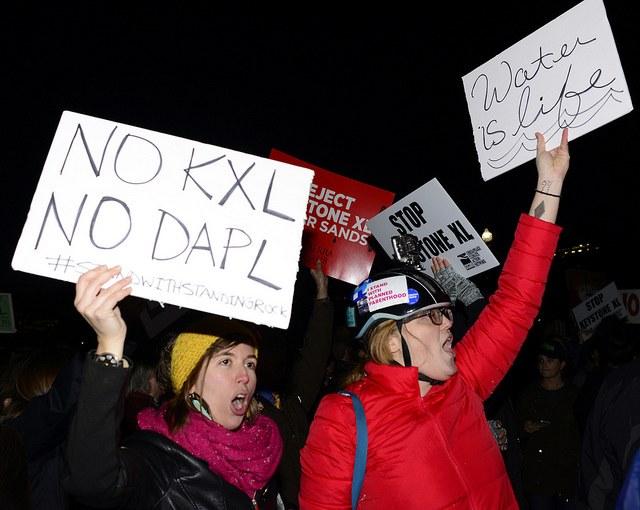

Uncertainty was in no short supply in the lead-up to Donald Trump's presidential inauguration. Last week, most conversations centered around the possibility of repealing the Affordable Care Act, more commonly known as Obamacare, without a replacement -- a move critics say could cost 2.6 million jobs (mostly in the private sector) and a cumulative $1.5 trillion loss in gross state products.
But as the new administration got down to business this week, the albatross of the unknown reached monumental proportions. And while the media was often distracted by Trump's over-estimated crowd sizes, "millions" of illegal voters and "big, beautiful" border wall, many insiders grew uneasy about the scope of the administration's early actions and the unpredictability of the Trump White House.
Don't expect us to clear it up for you, but we can all give it our best shot together. This week we're taking stock of what we know, what we don't know -- and whether or not it's truly time to panic.
Withdrawal from the Trans-Pacific Partnership
If you’re playing catch-up, here’s the gist. The Trans-Pacific Partnership is a trade deal between the United States and 11 other countries from the Pacific Rim region: Australia, Brunei, Canada, Chile, Japan, Malaysia, Mexico, New Zealand, Peru, Singapore and Vietnam.
The Obama administration supported the plan, but it was rife with controversy nearly from the start. Critics pointed to the fact that negotiations were closed to the public, but open to select business interests.
In October of last year, the Coalition for a Prosperous America and the American Sustainable Business Council spoke out against the TPP. The groups -- representing over 250,000 American businesses, primarily small- and medium-sized companies -- urged Congress not to hold a "lame duck" vote on the deal after the November elections.
"A President Clinton or a President Trump deserves the opportunity to re-examine trade policy with a new analysis to determine what works and what does not,” the groups said in their letter. Well, now that time has come.
On his first full day in office, President Donald Trump formally abandoned the TPP via executive order. Former presidential hopeful Sen. Bernie Sanders (I-Vt.) and several Rust Belt Democrats praised the decision, though many stopped short of complimenting Trump himself.
Opponents said the trade deal could carry unintended consequences like a rise in the U.S. trade deficit, a widening wage gap and a decline in American manufacturing. But not everyone is happy to see it go, with some experts warning a bow-out from the U.S. could leave the door open for an "era of Chinese-led trade deals."
Cutting federal regulations "by 75 percent"
Trump made a bold claim in a meeting with business leaders on Monday: "We think we can cut regulations by 75 percent. Maybe more, but by 75 percent."
As Chris Arnold of NPR pointed out, "Republicans do seem serious about some kind of regulatory reform." But is eliminating 75 percent of federal regulations even possible? Most experts say no.
One of those experts is Peter Van Doren, an economist with the Cato Institute, a free-market think tank. Historically, no president has been able to roll back regulations on anything resembling that scale, he told NPR. "I think it's gonna be probably somewhere in the moderate to small range," he predicted.
In fact, the real movement on rolling back back regulations may happen in Congress. In early January, the House passed the Regulations from the Executive in Need of Scrutiny Act of 2017, or REINS Act. If enacted, no agency could issue a new regulation unless it amended or repealed some other rule or rules “to completely offset any annual costs of the new rule to the American economy,” the Atlantic reported this week. It could also require Congressional approval for federal regulations set by agencies.
Muzzling science
Earlier this week, the Trump administration instructed employees at certain federal agencies to stop communicating with the public through news releases, official social media accounts and all forms of correspondence.
The gag order pertains to agencies whose work is science-based and involves the environment, namely the Environmental Protection Agency and divisions of the departments of Interior and Agriculture, reports 3p's RP Siegel.
It’s not unusual for a new administration to institute new policies concerning communication with the public. But given the free exchange of information we're used to in the digital age, the moves came as a shock.
And when the administration ordered the EPA to remove all references to climate change from its website, scientists became especially concerned. The administration appeared to back down from that plan later in the week. But to many experts, including us here at 3p, these apparent attempts to quash scientific discourse seemed strange at best.
Fortunately, some scientists are responding directly to the social media blackout and growing public concerns. Rogue Twitter accounts mimicking a number of federal agencies ordered to shut down social media began to pop up this week, garnering millions of followers. And a growing number of scientists say they're now considering a run for public office.
Turmoil in the State Department
On Wednesday, insiders were shocked to learn the State Department's entire senior-level management team tendered their resignations. "All are career Foreign Service officers who have served under both Republican and Democratic administrations," wrote Josh Rogin of the Washington Post, which first reported the resignations.
Since then, we've seen conflicting reports -- some saying the officials resigned rather than serve under Trump, and others saying the administration asked them to leave as part of an effort to "clean house." In any event, the move troubled experts.
“It’s the single biggest simultaneous departure of institutional memory that anyone can remember, and that’s incredibly difficult to replicate,” David Wade, who served as State Department chief of staff under Secretary of State John Kerry, told the Washington Post. “Department expertise in security, management, administrative and consular positions in particular are very difficult to replicate and particularly difficult to find in the private sector.”
Approval of Keystone XL and Dakota Access pipelines
On Tuesday, Trump cleared the way for construction to resume on the controversial Keystone XL and Dakota Access pipelines.
As a refresher: Keystone XL would carry heavy crude from the Alberta tar sands for over 1,100 miles through America's breadbasket to refineries on the U.S. Gulf Coast. Dakota Access would extend another 1,100 miles to bring crude from the Bakken oil fields of northwest North Dakota to a hub in Patoka, Illinois.
Critics long questioned the validity of Keystone XL, saying demand for tar sands drops significantly as oil prices fall. Climate advocates also worried about the use of tar sands oil, which is 17 percent worse for the environment than traditional forms of crude oil, from wellhead to tailpipe, according to the Natural Resources Defense Council. And this week many pointed to the State Department impact report that catalyzed the Obama administration's decision to reject the pipeline as a reason why it should not go forward.
The Dakota Access pipeline, which would pass within just half a mile of the Standing Rock Sioux reservation in North Dakota, is equally controversial. Members of the Standing Rock tribe, as well as thousands of other Native Americans and their supporters, fiercely protested the construction -- and many are still braving the North Dakota winter in protest camps near the pipeline site.
The administration says the pipelines will create jobs and help the U.S. gain energy independence. But critics say the risk to America's water sources is too great to bear, and eagerly point out that most of those jobs will be temporary and most of the oil that will travel through the pipelines is destined to be exported. The battle will likely rage on. But, environmental impact reports in hand, most in the sustainable business community view these pipelines as a stopgap measure at best -- and one that's unlikely to quell the rise of the clean-energy economy.
A change for automakers... maybe?
On Tuesday, Trump convened a meeting with the CEOs of Ford, General Motors and Fiat Chrysler to talk about bringing manufacturing jobs back the United States.
In the past, the new president said he would levy a selective 35 percent tax on companies that outsource production to other countries and then import goods back to the U.S., including automakers. He also sent angry tweets to GM and Toyota, scolding them for building cars in Mexico.
All things considered, Trump is hardly the first person to advocate for a revival of U.S. manufacturing -- particularly in the auto industry, which continued to outsource production even after receiving federal bailouts.
But the administration seemed to backtrack on Trump's border tax plans. Press secretary Sean Spicer initially floated a 20 percent border tax on Thursday. But White House Chief of Staff Reince Priebus quickly chimed in, saying the tax was merely part of a "buffet of options," reports USA Today.
So then what's the plan to stimulate American auto manufacturing? If the Atlantic's report of Tuesday's meeting is any indication, Trump aims to make America "more attractive" to automakers by rolling back environmental regulations -- a shift that may alienate Democrats who otherwise support steps to bolster U.S. manufacturing.
The mysterious infrastructure plan
On Wednesday, McClatchy and the Kansas City Star released a 50-item list of infrastructure priorities compiled by the Trump administration. The projects would cost at least $137 billion, though it's unclear whether the plan is finalized or simply a draft. The Star later reported the list came from a consulting firm. You can see the remarkably green-minded document here.
Infrastructure is one key area that may drive a rift between Trump and his Republican cohorts -- and make strange bedfellows of the new president and some of his most vocal critics.
Both Democratic presidential candidates -- Hillary Clinton and Bernie Sanders -- floated multibillion-dollar infrastructure plans on the campaign trail. President Barack Obama also proposed several infrastructure packages that were rejected by Congress, before the House and Senate passed their own $305 billion highway bill in 2015.
Although the $137 billion package released this week is worth far less than Trump's campaign promises -- he vowed to "double" the $275 billion in infrastructure spending proposed by his Democratic opponent, Hillary Clinton -- it gave a glimmer of hope to some seeking collaboration on Capitol Hill. The proposed package also includes spending on wind energy transmission and renewable energy storage -- another hint that this may be a point of contention between the White House and some Congressional Republicans.
Image credits: 1) Flickr/Gage Skidmore; 2) and 3) Flickr/Stephen Melkisethian
DOE SunShot Initiative Reaches $1 Per Watt Goal Three Years Early
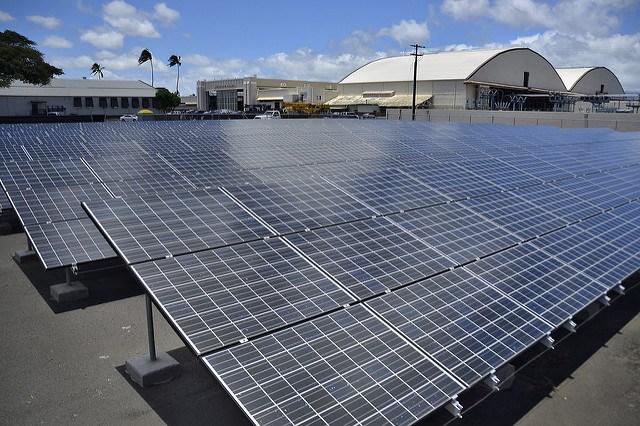

Lost in all the news over the silencing of scientists and the rogue Twitter accounts emerging as one form of protest against incoming President Donald Trump is a success story that can be traced back to the previous administration.
The cost of utility-scale solar power has plunged to the Obama administration's $1 per watt goal -- and three years early at that.
Now, a 2011 initiative that was once seen as more aspirational than realistic has the potential to transform the nation’s energy portfolio, Eric Wesoff of Green Tech Media inferred this week.
Many publications and financial analysts predicted the $1-a-watt magic metric was approaching “soon.” That “soon,” however, is today.
According to the Department of Energy, the SunShot initiative is largely the reason for the growth of solar across the United States. Five years ago, solar power contributed less than 0.10 percent, or 1.2 gigawatts, to the country’s electricity supply.
Five years later, solar still comprises a small part of the nation’s energy portfolio. But its growth has been exponential: More than 30 gigawatts, or over 1 percent of the nation’s power generation, now comes from solar.
Back in 2011, utility solar in America cost a little over $4 per watt on average. In February of that year, former Energy Secretary Steven Chu announced the SunShot initiative, which aimed to reduce the total costs of photovoltaic systems by 75 percent, to $1 per watt (about 6 cents per kilowatt hour) by 2020.
The program had four pillars:
- Improve the efficiency of solar cells
- Optimize electronics that would improve solar systems’ performance
- Boost the efficiency of solar manufacturing processes
- Streamline the installation, design and permitting processes nationwide
Critics derided the program as a farce, and often pointed to the Solyndra bankruptcy as evidence of a failed program. Meanwhile, China’s investments in solar technology led to a collapse in prices for solar panels and other equipment, often at the expense of American and German companies. Indeed, it was those cheap prices that has contributed to the solar boom in the U.S. and worldwide.
But the DOE’s efforts cannot be overlooked, despite some of the hurdles along the way. In hindsight, the Solyndra fiasco was more of a hiccup than a symptom of endemic failure in U.S. energy policy.
As Bloomberg noted in November, the federal energy loan program responsible for Solyndra (which started during the George W. Bush administration) ended up being a profitable venture for the U.S. government -- generating at least $1.65 billion in interest payments to date.
While the future of energy policy is uncertain, for now the Department of Energy keeps pressing ahead.
Last last year, it announced the SunShot initiative set new sights on solar affordability: Aiming to halve the average cost of utility-scale solar power to 3 cents per kilowatt-hour by 2030.
Under this new program, commercial photovoltaic power has a target of 4 cents per kWh; residential solar would decline to 5 cents per kWh. Judging by the program’s track record, such a target is hardly outlandish.
And with or without the Trump administration’s support, or specifically buy-in from new Energy Secretary Rick Perry, the private sector will continue to boost solar power’s efficiency while further lowering its price.
As Green Tech Media’s report points out, there are still costs that can be saved by improvements in labor, engineering, procurement and construction. Furthermore, as MIT Technology Review reminds us, that watt-per-hour metric is what engineering firms would bid to build a solar installation for a utility – but there are other costs, such as software, transmission lines, and the fact that energy storage technology is not yet at the point to let these systems deliver power 24/17.
But Chu’s initiative provided the much-needed spark: The goal, after all, was to make solar cost-effective enough so that it no longer needed subsidies to scale.
So Chu, who is now at Stanford University, can look back and know that he was probably the most successful, and consequential, energy secretary since the department was established in the 1970s.
For decades the DOE was an afterthought, as it was cobbled together by Jimmy Carter as a means to consolidate various energy agencies in a reaction to that decade’s volatile oil prices. Now, the department is a catalyst of innovation and economic development -- and a revenue generator.
While the current regime is hell-bent on removing any of Barack Obama’s fingerprints from the federal government, the new administration would be wise to look at the results and keep their hands off this program.
Image credit: U.S. Navy/Flickr
What We Lose if We Silence Science


Earlier this week, the Trump administration instructed employees at certain federal agencies to stop communicating with the public through news releases, official social media accounts and all forms of correspondence.
The order pertains to agencies whose work is science-based and involves the environment, namely the Environmental Protection Agency and divisions of the departments of Interior and Agriculture.
By some accounts, the restriction will be temporary, as a means of controlling messaging as the new regime takes over. But it's unclear when and if the orders will be lifted.
It’s not unusual for a new administration to institute new policies concerning communication with the public. But in these days, when information has been so readily available, particularly in light of Obama’s emphasis on transparency, this comes as a shock.
It wouldn’t be at all surprising to find that some scientists employed at these agencies are not in agreement with the direction the new president wants to go, particularly when it comes to protecting the environment. So, this could simply be seen as precautionary on his part to keep disgruntled employees from using social media to stir up public discontent as new policies are laid out. After all, it would never do to have federal employees whipping up emotions through their Twitter accounts -- unless, of course, they happen to live in the White House.
As outrageous as this is, some say it's merely Trump’s paranoia at play. But others feared a much darker possibility after the new administration ordered the EPA to remove all references to climate change from its website.
The EPA, as a representative institution of the U.S. government, has long been held as a bastion of scientific fact where citizens could safely turn for unbiased information regarding environmental issues. Indeed, since its inception the EPA has been a refuge against the bias of corporate attempts to whitewash, or greenwash, the hazards posed by products that were turning profits for them. Now it appears that the government itself, in collusion with industry, wants to inject its own bias to support those profits -- particularly with respect to the fossil fuel industry.
On Wednesday, the administration appeared to back down from its plans to remove climate change references from EPA.gov. "We've been told to stand down," an EPA employee told E&E News, as reported by Science Magazine. At this writing, the EPA's climate page is still online.
The issue of climate change is far too important and too urgent to be swept under the rug in the name of the kind of supercharged capitalism that Trump believes is the answer to all of our problems. The American people need to know what their government is doing. And any attempt to conduct the business of government under a cloak of darkness is a dramatic move away from Democracy. It’s also worth remembering that we the people are paying for these agencies through our tax dollars and that they work for us.
This newly declared war on truth, the attempt to feed the American public a diet of “alternative facts,” in order to enact controversial policies without any reporting, other than that of the administration’s spin, is taken directly out of the playbook of history’s most totalitarian regimes. The practice has long been known as propaganda. It’s clear that if one is to declare war on truth, one must silence the media and the scientific community first.
As New York Times columnist Charles Blow wrote in an op/ed on Thursday: “…Now that he has been elected, Trump wants absolute control over the flow of information, to dictate his own version of facts rather than live with the reality of accepted facts. Trump is in a battle to bend the truth to his benefit.”
Fortunately, rogue Twitter accounts mimicking a number of federal agencies ordered to shut down social media have begun to pop up online. The accounts claim to be run by current or former agency employees, maintained during their own free time in a brave attempt to keep the American people informed during this time when freedom of information is under attack.
Image credits: 1) Flickr/Uncalno Tekno; 2) @AltNatParkSer on Twitter
Emissions Cuts Helped Business Leaders Save $12.4 Billion Last Year
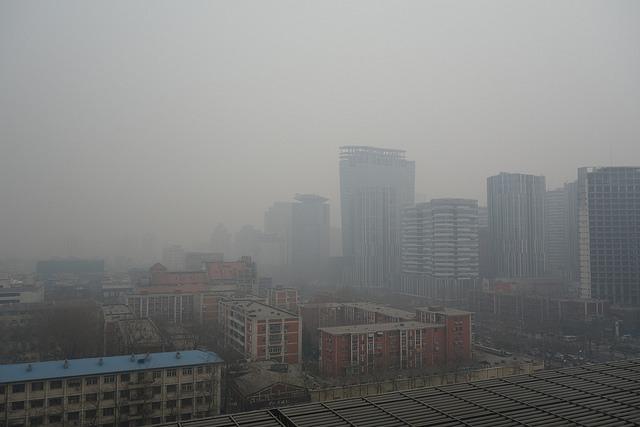

As the supply chains of multinational companies become more complex, so does the potential for increased carbon emissions as more products incorporate more parts and materials from across the globe. And as companies become more desperate to shave costs, more goods are produced in countries where environmental regulations tend to be weaker than in wealthier nations.
Nevertheless, evidence suggests that a more sustainable and efficient supply chain can mitigate a company's impact on the environment, while scoring the buy-in of the chief financial officer.
As CDP noted in a recent report, the efforts of its 89 supply chain members reduced carbon emissions by at least 434 million tons last year.
But this metric will really attract the CFO's attention: In 2016 alone, emissions cuts netted a combined $12.4 billion in cost savings for those firms, which include the likes of Unilever, Microsoft, Ford and Walmart.
Only half of the companies surveyed for this report revealed cost savings – but those that did claimed huge gains. And while it may at first appear cliché, a large part of these savings come from engagement, engagement, engagement.
For example, the global semiconductor giant Intel took a carrot-and-stick approach to gaining disclosures from its suppliers. First, CDP reporting expectations were integrated into the company’s supplier scorecards. Next, participation in Intel’s surveys was required for vendors to be eligible for the company’s supplier awards. Finally, Intel provided its suppliers with training and regular communications updates so these smaller firms would know what to do and how to go about making the necessary changes.
Not that such a feat is easy. The automaker BMW Group, for example, has at least 13,000 suppliers spread across 70 nations. So BMW began by incorporating CDP disclosures into annual supplier performance reviews for its 100 largest vendors. The company first set annual internal targets, then key performance indicators (KPIs) that include transparency goals as well as carbon emissions targets. Sixty-nine percent of the company’s annual spend is now accounted for by CDP-related disclosures.
According to CDP, 83 percent of its supply chain members’ cost savings can be attributed to four general types of programs. Over a third of these companies’ total cost savings comes from better product design. Waste diversion and recovery accounts for 28 percent of these total savings. Efficient transportation and energy efficiency processes round out the largest money savers for these companies.
The diverse industries represented in this report shows that for any company with a large global presence, designing better products and using resources more efficiently can only add to the bottom line. And at a time when many governments indicate they may back off from pledges made at the COP21 climate talks in Paris, the private sector can show that it can step up and lead the way toward a low-carbon economy.
More improvement on this front is needed, however.
As Patricia Espinosa, executive secretary of the United Nations Framework Convention on Climate Change (UNFCCC), wrote in the report’s forward: “Only 22 percent of supplier organizations that responded to the 2016 CDP Supply Chain information request actively engage with their suppliers. It is not enough.”
Image credit: Kentaro Iemoto/Flickr